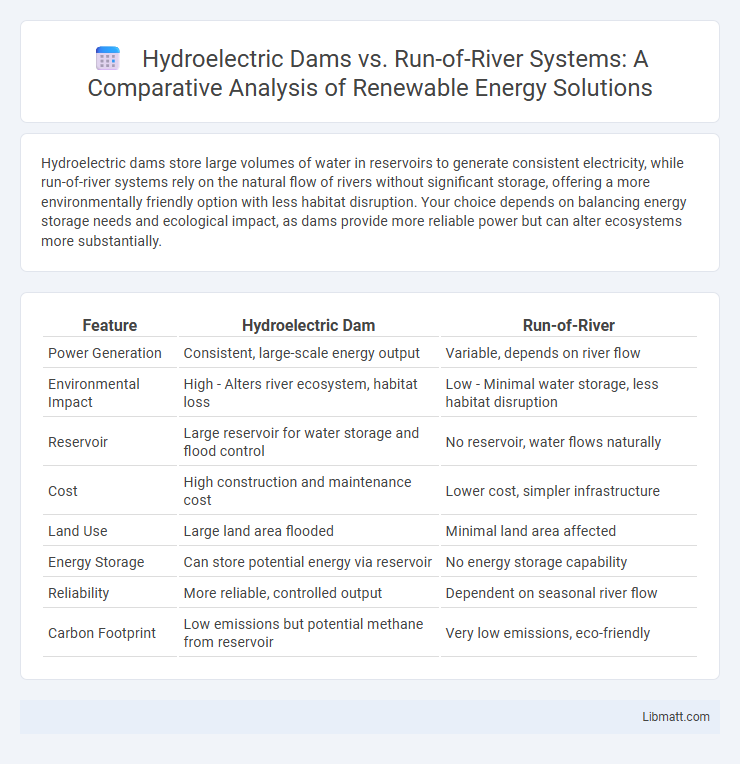Hydroelectric dams store large volumes of water in reservoirs to generate consistent electricity, while run-of-river systems rely on the natural flow of rivers without significant storage, offering a more environmentally friendly option with less habitat disruption. Your choice depends on balancing energy storage needs and ecological impact, as dams provide more reliable power but can alter ecosystems more substantially.
Table of Comparison
| Feature | Hydroelectric Dam | Run-of-River |
|---|---|---|
| Power Generation | Consistent, large-scale energy output | Variable, depends on river flow |
| Environmental Impact | High - Alters river ecosystem, habitat loss | Low - Minimal water storage, less habitat disruption |
| Reservoir | Large reservoir for water storage and flood control | No reservoir, water flows naturally |
| Cost | High construction and maintenance cost | Lower cost, simpler infrastructure |
| Land Use | Large land area flooded | Minimal land area affected |
| Energy Storage | Can store potential energy via reservoir | No energy storage capability |
| Reliability | More reliable, controlled output | Dependent on seasonal river flow |
| Carbon Footprint | Low emissions but potential methane from reservoir | Very low emissions, eco-friendly |
Introduction to Hydroelectric Dam and Run-of-River Systems
Hydroelectric dams generate electricity by storing massive water volumes in reservoirs, utilizing gravitational potential energy to drive turbines with controlled water release. Run-of-river systems produce power by channeling flowing river water through turbines without significant water storage, relying on natural flow variations. Your choice depends on energy demands, environmental impact, and site-specific hydrological conditions.
Key Differences Between Hydroelectric Dams and Run-of-River Plants
Hydroelectric dams store large volumes of water in reservoirs, allowing controlled electricity generation and flood management, while run-of-river plants rely on natural river flow without significant storage, resulting in variable power output. Dams typically require substantial construction and environmental alterations, impacting aquatic ecosystems more than the minimal footprint of run-of-river systems. Your choice between these technologies depends on site conditions, energy demands, and environmental priorities.
How Hydroelectric Dams Work
Hydroelectric dams generate electricity by harnessing the potential energy of stored water in a reservoir, which flows through turbines to produce mechanical energy converted into electrical power. The process involves controlling water release to maintain consistent pressure and flow, ensuring steady energy output. In contrast, run-of-river systems rely on the natural flow of a river without large reservoirs, producing variable energy depending on current water levels.
Run-of-River: Principles and Operation
Run-of-river hydroelectric systems generate electricity by diverting a portion of river flow through a penstock without large reservoirs, relying on natural river currents and elevation drop to drive turbines. This method minimizes environmental impact by maintaining river ecosystems and avoiding significant water storage, but the power output fluctuates with seasonal river flow variations. Unlike traditional hydroelectric dams, run-of-river installations provide sustainable, low-head hydroelectric energy with less disruption to aquatic habitats and sediment transport.
Environmental Impact: Dam vs Run-of-River
Hydroelectric dams significantly alter local ecosystems by flooding large areas, disrupting fish migration, and changing sediment flow, which can lead to habitat loss and water quality issues. In contrast, run-of-river systems have a lower environmental impact since they divert part of the river flow without large reservoirs, maintaining more natural river conditions and preserving aquatic biodiversity. However, run-of-river projects still affect river flow and can impact fish populations, though generally to a lesser extent than conventional dam reservoirs.
Energy Efficiency and Output Comparison
Hydroelectric dams typically achieve higher energy efficiency and output by storing large volumes of water to regulate flow and generate consistent electricity, often exceeding 90% efficiency. Run-of-river systems rely on natural stream flow without significant storage, resulting in variable output and generally lower efficiency, usually between 50% to 80%. The ability of hydroelectric dams to control water release enables greater power stability and peak load management compared to the intermittent nature of run-of-river installations.
Cost and Infrastructure Considerations
Hydroelectric dams require significant upfront investment in large-scale infrastructure, including reservoirs, spillways, and turbines, resulting in higher construction and maintenance costs compared to run-of-river systems. Run-of-river plants leverage existing river flow without large reservoirs, leading to lower capital expenses and reduced environmental impact but limited energy storage capacity. Cost efficiency of run-of-river projects depends on consistent river flow, making them suitable for specific geographic locations with minimal infrastructure requirements.
Water Management and Flood Control
Hydroelectric dams offer extensive water management capabilities, enabling controlled reservoir storage and release to mitigate flood risks and ensure water availability during dry periods. Run-of-river systems rely on natural river flow with minimal storage, limiting their ability to regulate water levels or control flooding effectively. Consequently, traditional dams play a crucial role in flood control and seasonal water supply stability, whereas run-of-river projects prioritize ecological flow continuity over large-scale water management.
Social and Community Implications
Hydroelectric dams often lead to significant displacement of local communities and alter traditional livelihoods due to large reservoir flooding, whereas run-of-river projects typically have a smaller footprint, minimizing resettlement and maintaining local ecosystems. The social impacts of large dams frequently include loss of arable land, cultural site submersion, and changes in fisheries, which can disrupt community cohesion and heritage. In contrast, run-of-river systems support sustainable energy with fewer disruptions to communities by preserving river flow regimes and reducing environmental and social conflicts.
Future Trends in Hydropower Generation
Future trends in hydropower generation emphasize greater integration of run-of-river systems due to their lower environmental impact compared to traditional hydroelectric dams, which often involve large reservoirs and ecosystem disruption. Advances in turbine technology and smart grid integration enhance the efficiency and reliability of run-of-river projects, making them more viable for sustainable energy production. Your energy strategy can benefit from these innovations, aligning with global efforts toward greener and more resilient hydropower solutions.
Hydroelectric dam vs Run-of-river Infographic

 libmatt.com
libmatt.com